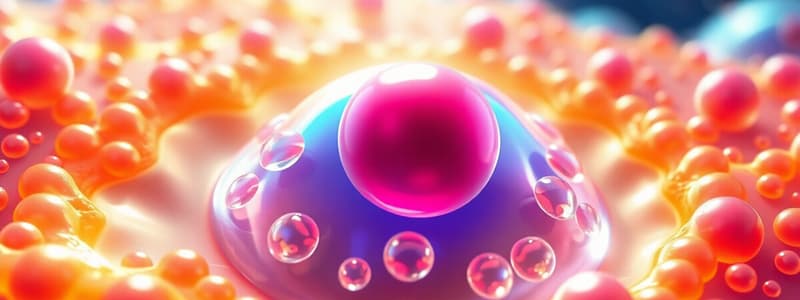Podcast
Questions and Answers
What is the primary role of receptor-mediated endocytosis in cells?
What is the primary role of receptor-mediated endocytosis in cells?
- To secrete hormones directly into the bloodstream.
- To take in specific molecules after they bind to receptors. (correct)
- To facilitate the movement of substances along microtubules.
- To remove waste products from the cell.
Which structure is involved in removing materials from the cell during exocytosis?
Which structure is involved in removing materials from the cell during exocytosis?
- Golgi apparatus
- Lysosome (correct)
- Cytoplasm
- Microtubules
In what way do receptor proteins influence the process of endocytosis?
In what way do receptor proteins influence the process of endocytosis?
- They release waste products when activated.
- They react with catherines to engulf molecules. (correct)
- They directly transport substances through the cytoplasm.
- They secrete enzymes that facilitate binding.
What is one of the main purposes of exocytosis in animal cells?
What is one of the main purposes of exocytosis in animal cells?
What cellular component assists the movement of substances during endocytosis and exocytosis?
What cellular component assists the movement of substances during endocytosis and exocytosis?
What characteristic of phospholipids allows them to form a bilayer structure spontaneously?
What characteristic of phospholipids allows them to form a bilayer structure spontaneously?
Which of the following statements about membrane fluidity is true?
Which of the following statements about membrane fluidity is true?
What factors can influence the fluidity of the phospholipid bilayer?
What factors can influence the fluidity of the phospholipid bilayer?
Which class of lipids is NOT included in the three distinct classes of lipids found in cells?
Which class of lipids is NOT included in the three distinct classes of lipids found in cells?
What is the role of fatty acid desaturases in bacterial cells?
What is the role of fatty acid desaturases in bacterial cells?
How does thermal environment affect the phospholipid bilayer?
How does thermal environment affect the phospholipid bilayer?
What part of the phospholipid interacts with water?
What part of the phospholipid interacts with water?
What describes the physical state of saturated fatty acids at room temperature compared to unsaturated fatty acids?
What describes the physical state of saturated fatty acids at room temperature compared to unsaturated fatty acids?
What characteristic of water makes it unable to cross the lipid bilayer easily?
What characteristic of water makes it unable to cross the lipid bilayer easily?
Which structural feature of transmembrane proteins allows them to embed within the lipid bilayer?
Which structural feature of transmembrane proteins allows them to embed within the lipid bilayer?
What is a defining feature of transmembrane domains?
What is a defining feature of transmembrane domains?
Which type of protein is commonly associated with linking directly to chemical bonding domains?
Which type of protein is commonly associated with linking directly to chemical bonding domains?
Why might a protein with only a single transmembrane domain be effective?
Why might a protein with only a single transmembrane domain be effective?
What type of secondary structure can be found in transmembrane proteins?
What type of secondary structure can be found in transmembrane proteins?
How do polar regions of transmembrane proteins interact with the environment?
How do polar regions of transmembrane proteins interact with the environment?
What role do aquaporins serve in cellular membranes?
What role do aquaporins serve in cellular membranes?
What occurs to a plant cell placed in a hypotonic solution?
What occurs to a plant cell placed in a hypotonic solution?
Which statement best describes the role of aquaporins in cells?
Which statement best describes the role of aquaporins in cells?
What phenomenon occurs when a plant cell loses water and the cell membrane detaches from the cell wall?
What phenomenon occurs when a plant cell loses water and the cell membrane detaches from the cell wall?
Why do animal cells need to be in isotonic environments?
Why do animal cells need to be in isotonic environments?
What is the primary function of contractile vacuoles in certain protists?
What is the primary function of contractile vacuoles in certain protists?
What prevents a plant cell in a hypotonic solution from bursting?
What prevents a plant cell in a hypotonic solution from bursting?
In isotonic regulation, what must cells do to maintain equilibrium?
In isotonic regulation, what must cells do to maintain equilibrium?
Which group of organisms are known for having cell walls that help control osmotic pressure?
Which group of organisms are known for having cell walls that help control osmotic pressure?
Which condition does NOT affect the direction of diffusion across a membrane?
Which condition does NOT affect the direction of diffusion across a membrane?
What occurs when carrier proteins become saturated with their target molecules?
What occurs when carrier proteins become saturated with their target molecules?
In which scenario would a cell placed in a hypertonic solution experience a net movement of water?
In which scenario would a cell placed in a hypertonic solution experience a net movement of water?
Osmosis predominantly involves the movement of which substance?
Osmosis predominantly involves the movement of which substance?
If a plant cell were placed in a hypertonic solution, what immediate effect would occur?
If a plant cell were placed in a hypertonic solution, what immediate effect would occur?
What role do carrier proteins serve in cellular transport?
What role do carrier proteins serve in cellular transport?
What is true about the concentration of water and solutes in osmosis?
What is true about the concentration of water and solutes in osmosis?
Which type of solution has a lower solute concentration relative to the inside of a cell?
Which type of solution has a lower solute concentration relative to the inside of a cell?
Flashcards are hidden until you start studying
Study Notes
Membrane Lipids
- Lipidomics examines the quantity and function of lipids within a cell.
- Lipids are comprised of hydrophilic tails exposed to water and hydrophobic tails that are not exposed to water.
- Cells contain around 1,000 distinct lipids, classified into three groups: glycerol phospholipids, sphingolipids, and sterols.
- The arrangement of hydrophilic heads and hydrophobic tails within a bilayer is the reason why lipids can be separated.
Phospholipids
- Consist of two layers of proteins and lipids that spontaneously form a bilayer due to their amphipathic nature.
- The polar head group is hydrophilic and contains a phosphate group.
- The two fatty acids are nonpolar and hydrophobic, exhibiting a parallel arrangement.
- Phospholipids spontaneously form a bilayer due to the attraction of their polar head groups to water and the repulsion of their hydrophobic tails from water.
The Phospholipid Bilayer (Cellular Membrane)
- Composed of phospholipids, the bilayer functions as a fluid structure.
- Proteins are free to move within the bilayer like ice floating in a river.
- Hydrogen bonding between water molecules and the polar heads holds together the phospholipid layers.
- Individual phospholipids and unanchored proteins can freely move through the membrane.
- The fluid nature of the bilayer is demonstrated by the movement of proteins and lipids.
Influences on Fluidity of the Phospholipid Bilayer
- Saturated fatty acids decrease membrane fluidity compared to unsaturated fatty acids.
- Warmer temperatures increase membrane fluidity relative to colder temperatures.
- The lipid composition of the endoplasmic reticulum membrane, Golgi stack, and plasma membrane exhibits distinct differences.
Transmembrane Proteins
- Span the lipid bilayer with nonpolar regions embedded in the interior of the bilayer.
- Polar regions of the protein protrude from the bilayer's exterior and interior surfaces.
- Transmembrane proteins are crucial for transport across the membrane as they exhibit both polar and nonpolar regions.
- Polar regions of the protein can interact with the aqueous environments on either side of the membrane, while the nonpolar regions interact with the hydrophobic interior of the bilayer.
- The presence of transmembrane proteins allows for the transport of molecules that cannot easily pass through the nonpolar lipid bilayer, including water.
Transmembrane Domains
- Act as membrane-spanning regions, typically composed of hydrophobic amino acids arranged in α helices.
- Proteins can possess single or multiple transmembrane domains to anchor them to the membrane.
- The classification of receptor types often depends on the number of transmembrane domains present.
Carrier Proteins
- Facilitate the transport of ions and other solutes, such as sugars and amino acids.
- Transport is facilitated by diffusion and relies on a concentration difference across the membrane.
- Carrier proteins must bind to the molecule they transport to move them through the membrane.
- Saturation occurs when the rate of transport is limited due to the number of available transporters.
Osmosis
- The cytoplasm of the cell comprises an aqueous solution where water is the solvent and dissolved substances are solutes.
- Osmosis refers to the net diffusion of water across a semipermeable membrane, moving towards a region with a higher solute concentration.
- When discussing solute concentration, a higher solute concentration signifies a lower concentration of water molecules.
Osmotic Concentration
- When two solutions exhibit different osmotic concentrations, they are categorized as:
- Hypertonic solution: Higher solute concentration.
- Hypotonic solution: Lower solute concentration.
- Isotonic solutions have the same osmotic concentration.
- Aquaporins, specialized channels for water in the cell membrane, facilitate osmosis.
Osmotic Pressure
- The force required to halt osmotic flow.
- A cell immersed in a hypotonic solution gains water, causing swelling and creating pressure.
- Plant cells possess cell walls that prevent them from bursting due to excessive water intake.
- Animal cells require isotonic environments to maintain homeostasis and prevent bursting.
Maintaining Osmotic Balance
- Cells employ mechanisms to regulate water balance by taking in or expelling water.
- Extrusion involves the ejection of water through contractile vacuoles, utilized by organisms like Paramecium and Amoeba.
- Isosmotic regulation involves maintaining cellular isotonicity with the surrounding environment, employed by marine organisms to match their internal concentration to seawater.
Endocytosis
- The process of taking substances into the cell.
- Receptor-mediated endocytosis involves specific molecules binding to receptors on the cell membrane, triggering their internalization.
Exocytosis
- The process of releasing substances from the cell.
- Cells utilize exocytosis to expel waste products, transport products for other cells, or secrete hormones, neurotransmitters, and digestive enzymes.
- Exocytosis requires energy to move substances outside the cell.
- The Golgi apparatus and endoplasmic reticulum often play a role in producing cell wall material, which can be exported through exocytosis.
Studying That Suits You
Use AI to generate personalized quizzes and flashcards to suit your learning preferences.




